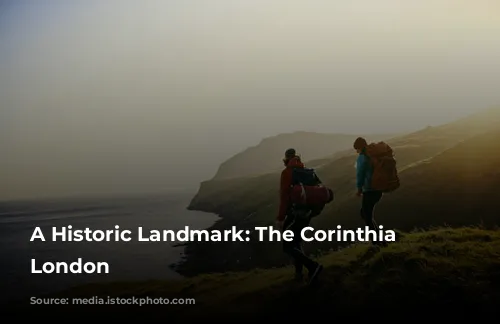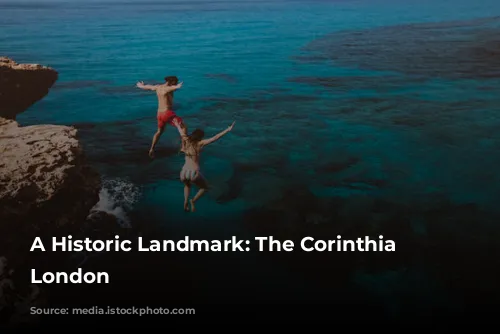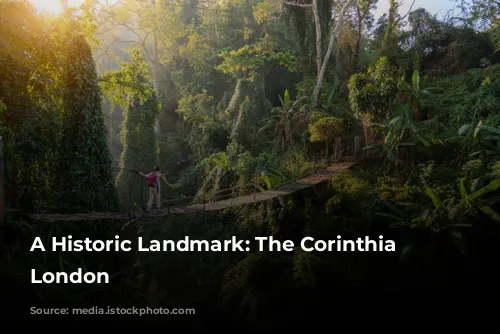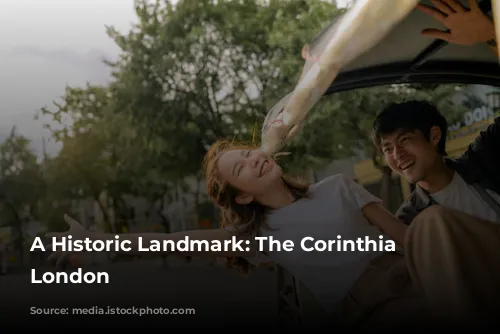The Corinthia Hotel London, situated in the heart of the city, has a fascinating history intertwined with the grandeur of British government and the allure of luxury hospitality. This iconic building has witnessed pivotal moments in history, from royal receptions to wartime operations, leaving an indelible mark on the cityscape.
A Grand Beginning: The Metropole Hotel
The Metropole Hotel, as it was originally known, opened its doors in 1885, boasting a prime location near the Palace of Westminster and the government offices of Whitehall. Its elegance and strategic positioning quickly attracted influential figures, establishing it as a social hub for the elite.
The hotel’s charm extended beyond its opulent interiors, hosting prestigious events like the annual dinners of the Aero Club and the Alpine Club. The hotel was also the starting point for the first London to Brighton car race in 1896, highlighting its connection to the burgeoning world of motorsports.
Prince of Wales, who later became King Edward VII, was a frequent visitor, enjoying the hotel’s lavish ballroom and the Royal Suite, a testament to its royal allure.
A Shift to Service: The Metropole as a Government Building
The outbreak of World War I marked a turning point for the hotel. Its strategic location made it an essential asset for the government, and it was requisitioned to house government staff.
The Metropole became a symbol of wartime service, hosting prominent figures like Field Marshals John French and Douglas Haig, the Commanders-in-Chief of the British Expeditionary Force.
The “Midnight Follies”, a popular cabaret, breathed life back into the hotel after the war, attracting the attention of the public and marking a return to its social vibrancy.
Bert Firman, a young violinist, rose to fame at the Metropole, becoming the youngest bandleader in the world at the age of sixteen. His talent and the hotel’s lively atmosphere attracted renowned musicians like Mantovani to its stage.

A Sporting Triumph: The Metropole’s Role in Rugby History
The Metropole Hotel witnessed a significant moment in rugby history. On January 4, 1936, the England Rugby Union team triumphed over the New Zealand All Blacks, with Prince Alexander Obolensky’s legendary try securing a historic victory.
The England team celebrated their victory at the Metropole, sharing the moment with their opponents, the New Zealand All Blacks, who were also guests at the hotel. This shared experience further cemented the hotel’s place in sporting history.

Back to Government Service: The Metropole’s Wartime Role
The government’s expansion into the Whitehall area led to the requisitioning of the Metropole once again. Initially used by the Ministry of Labour and the Ministry of Transport, it later housed the Air Ministry and the Ministry of Defence.
The hotel became a vital hub for the government during World War II, playing a significant role in the war effort. Room 424 became the headquarters for MI9 and the Special Operations Executive, highlighting its strategic importance.
The Metropole was also a key location for the planning of Operation Overlord, demonstrating its contribution to the Allied victory.

A Transformation: The Rebirth of the Corinthia Hotel
After World War II, the Metropole was purchased by the Crown Estate and became a permanent part of the Ministry of Defence’s complex. It continued to serve as a government building, with the Air Ministry and the Defence Intelligence Staff occupying its spaces.
The hotel’s grandeur was also reflected in its appearance in the James Bond comic strip, showcasing its image as a sophisticated and influential location.
In 2007, a consortium purchased the Metropole building, marking the beginning of its transformation into the Corinthia Hotel. The building underwent a meticulous restoration, transforming it into a luxury hotel and residential complex.
The reopening of the Corinthia Hotel in 2011 celebrated its rich heritage and modern elegance. The hotel incorporated its past with its present, offering a luxurious experience for guests.

A Modern Landmark: The Corinthia’s Continued Legacy
The Corinthia Hotel continues to play a prominent role in the city’s landscape, hosting high-profile events and attracting international attention.
The official announcement of the James Bond movie “Skyfall” took place at the hotel in 2011, reinforcing its connection to cinematic history. The hotel also served as a prominent location in the thriller “Red Sparrow,” showcasing its enduring cinematic charm.
The Corinthia Hotel’s Artist in Residence program fosters creativity and showcases the talent of emerging artists, reflecting its commitment to the arts and cultural vibrancy.
The Corinthia Hotel London stands as a testament to the city’s history, reflecting the changing tides of time and the enduring power of its grandeur. It remains a vibrant landmark, offering a glimpse into the past while embracing the future, captivating visitors with its rich history and sophisticated elegance.








